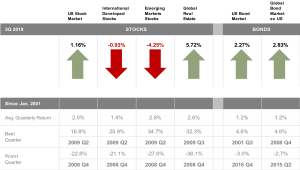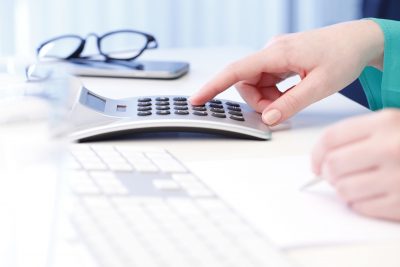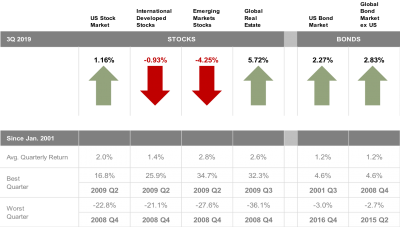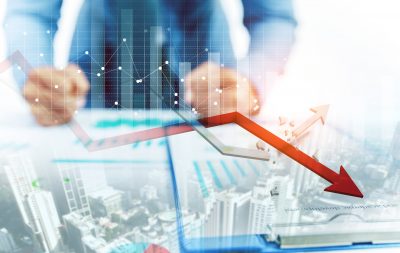What Happens When you Fail at Market Timing?
The impact of missing just a few of the market’s best days can be profound, as this look at a hypothetical investment in the stocks that make up the S&P 500 Index shows. A hypothetical $1,000 turns into $138,908 from 1970 through the end of August 2019. Miss the S&P 500’s five best days and that’s $90,171. Miss the 25 best days and the return dwindles to $32,763. There’s no proven way to time the market—targeting the best days or moving to the sidelines to avoid the worst—so history argues for staying put through good times and bad. Investing for the long term helps to ensure that you’re in the position to capture what the market has to offer.
October Performance Dashboard
-
U.S. equities posted gains in October, bolstered by optimism around trade talks with China, strong earnings, and easing from the Fed, although Chairman Powell signaled a likely pause on future rate cuts. The S&P 500® and the S&P SmallCap 600® both gained 2%, while the S&P MidCap 400® gained 1%.
-
International markets also gained, with the S&P Developed Ex-U.S. and the S&P Emerging BMI both up 4%.
-
Enhanced Value continued to outperform in October, and Value again outperformed Growth. Year-to-date, Low Volatility remains the top performing factor index, up an impressive 26%.
Kids’ future or yours? 6 Tips to Balance College and Retirement
Get the facts about saving for retirement and college at the same time. Understanding that funding each is equally important, and that even a late start is a good start. Every dollar saved is a dollar you don’t have to borrow.
IND_FlyerQuarterly Market Review Q3 – 2019

This report features world capital market performance and a timeline of events for the past quarter. It begins with a global overview, then features the returns of stock and bond asset classes in the US and international markets.
The report also illustrates the impact of globally diversified portfolios and features a quarterly topic.
Click HERE to download this quarter’s breakdown!
September Performance Dashboard
-
In spite of slowing economic growth, ongoing trade tensions and a presidential impeachment inquiry, U.S. equities recovered in September to end the third quarter on a positive note. Year-to-date, large-caps outperformed mid- and small-caps, with the S&P 500® up 21%, while the S&P MidCap 400® and S&P SmallCap 600® gained 18% and 13%, respectively.
-
Despite gains in September, international markets ended the quarter with losses while holding on to year-to-date gains, with the S&P Developed Ex-U.S. and the S&P Emerging BMI up 13% and 8%, respectively.
-
Enhanced Value outperformed its factor peers in September, and Value outperformed Growth, but time will tell whether this reversal continues. Year-to-date, Low Volatility remains the top performing factor index, up a remarkable 26%.
Get a FREE benefits review!
It’s open enrollment in the American workplace every fall, and employers will begin to pass out packets, forms, memos, hold meetings and launch apps for the benefits enrollment season. Navigating your benefits package can be overwhelming, and has a direct effect on your long-term savings. WE WANT TO HELP!
Below is your quick guide to navigating your benefits booklet from start to finish:
Health Insurance – pay close attention to the following variables to the health insurance options:
- Coverage – compare what’s covered to your anticipated needs, i.e. maternity?
- Co-payments and Prescriptions – if you go to the doctor often, or have a recurring prescription to fill, evaluate these fees closely.
- Deductibles – the amount you have to pay out of your pocket before coverage begins. A high deductible plan typically means lower premiums, but participants pay more out of pocket if an unexpected illness occurs.
- Premiums – the monthly fee for coverage. A higher premium usually means lower deductibles, co-pays and more coverage. But that’s not always the best financial choice.
Tax advantaged accounts – beyond health coverage, these accounts allow you to save pre-tax dollars for ancillary health and other expenses.
- FSA (Flexible Savings Account) – similar in tax savings, a FSA allows you to use the funds for medical and child care services. There are limits to contributions and to carry over funds.
- HSA (Health Savings Account) – contribute to this account to help cover medical expenses you are paying out of pocket. Choosing a high deductible plan warrants opening an HSA due to the anticipated higher out of pocket costs. These funds roll over from year-to-year.
Vision and Dental – Simply put…
- Dental care is expensive. Insurance doesn’t cover a lot, but what it does cover usually outweighs the cost of the dental care without it.
- Vision care is inexpensive, but sometimes unnecessary. If you have healthy eyes you need a checkup only every 2 years, so vision premiums may not be worth it.
Life and Disability – Important Voluntary Benefits!!!
- Short-term Disability – are you covered for a short-term illness or injury?
- Long-term Disability – if you are unable to work for an extended period of time, how will you pay your bills?
- Life Insurance – How much should you leave your family if something happens to you?
401(k) – the likely #1 source of retirement savings, this benefit is the major player in your ability to retire.
- Make a goal to increase your contributions every year
- Take full advantage of your employer’s match
- Make catch-up contributions if you are eligible
- Evaluate the need to defer some of your funds to a Roth 401(k) to provide future tax diversification.
- Evaluate your risk tolerance and allocate appropriately
- Choose low-cost funds
The best way to make the most of open enrollment is to simply set aside adequate time to review all your options carefully and ask any questions you may have. Consult with your financial advisor, as these benefits choices will affect your long-term savings. To make the most of open enrollment, read the fine print, consider your family’s needs and make an educated, rather than a rash, decision. We are here to help you navigate these important choices. Please let us know if you would like a more detailed COMPLIMENTARY REVIEW of your benefits booklet!
David Booth On: Forecasting
Dimensional Founder David Booth shares his perspective on the limitations of market forecasting in this less than two minute video. Instead of enticing people to try to stock-pick, Dimensional wants to educate investors, with the over 90 years of data, on investing in capital markets.
Life Insurance – What is your Human Life Value?

September is LIFE INSURANCE AWARENESS MONTH so we are starting a drive to help clients and friends review and shop for the best and most appropriate coverage possible.
DID YOU KNOW…A recent survey found only 32% of Americans have life insurance.
How would you assess the financial loss your family would incur if you were to die today? Are you the sole provider for your family, or at least a significant provider to the family budget? If you had a money making machine in your home, would you insure it? Life insurance is not for you, it’s for your loved ones once you’re gone.
This calculator provides only a rough estimate of your human life value, which can factor into how much insurance you need.
HUMAN LIFE VALUE CALCULATOR
After calculating a typical lifetime income based on your specific circumstances, you’ll see a final number that gives an approximate measure of your net contribution to your family—your human life value. This should not be considered a comprehensive assessment, as it only takes generalities into account. Still, given the limited information you’re providing, we believe it is the best estimate available.
NOT SURE WHERE TO START ASSESSING YOUR NEEDS? START HERE!
Contact us TODAY to get a FREE assessment of your life insurance needs, and a FREE QUOTE!
855-PARKELM OR kward@park-elm.com
A Tale of Two Decades
Looking at the stock market over the past 20 years, you might think of Charles Dickens: It was the best of times—and the worst. But while the 2000s and 2010s have differed starkly in performance, collectively they have reinforced investing lessons on patience and discipline.
This piece from our partner, Dimensional Funds, discusses the well supported thought that maintaining patience and discipline, through the bad times and the good, puts investors in position to increase the likelihood of long‑term success.
Click here to download A Tale of Two Decades!
…or check it out below:











